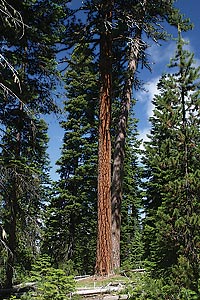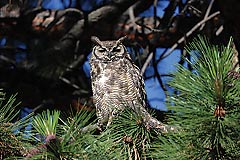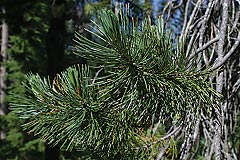 Alexandra Murphy author of Graced by Pines: The Ponderosa Pine in the American West writes, “Pines are living constants in the landscape. They hold the West’s history, both in the rings of their heartwood, hidden within like human memory, and in the outward manifestations of their daily living – in their blackened fire scars, the borings of beetles and woodpeckers, the goshawk nests high in their wolfy crowns, the wind-sculpted drape of their branches, and the stumps, smooth as tables, left by logging.”
Alexandra Murphy author of Graced by Pines: The Ponderosa Pine in the American West writes, “Pines are living constants in the landscape. They hold the West’s history, both in the rings of their heartwood, hidden within like human memory, and in the outward manifestations of their daily living – in their blackened fire scars, the borings of beetles and woodpeckers, the goshawk nests high in their wolfy crowns, the wind-sculpted drape of their branches, and the stumps, smooth as tables, left by logging.”
Ranging from southern Canada to Mexico and from the Pacific states to the Great Plains, ponderosa pines have the greatest distribution of any western pine. The pines prefer drier locations, from the rain shadow along the eastern edge of the Cascades and Sierras across the Intermountain West, than some of their distant cousins like Douglas-fir or mountain hemlock.
Well know to the indigenous people of North America long before European explorers entered the western interior, ponderosa woodlands provided them with wildlife, wild plants, and building materials. In Chaco Canyon National Historic Park, located in northwest New Mexico, over 150,000 ponderosa logs were used in the construction of Pueblo Bonito and Chetro Ketl around 900 A.D.
 Fast forward to the early 1800s to when Meriwether Lewis and William Clark and the Corps of Discovery were entering into a vast unknown land, the American West. Near Orofino, Idaho Lewis collected samples for science of this massive tree and named it “long-leaf pine” after the length of the needles. His collection eventually became lost and it would be another 25 years before the young Scottish plant collector David Douglas would encounter the pine during his Northwest explorations and name the tree Pinus ponderosa, ponderosa pine, for its massive stature.
Fast forward to the early 1800s to when Meriwether Lewis and William Clark and the Corps of Discovery were entering into a vast unknown land, the American West. Near Orofino, Idaho Lewis collected samples for science of this massive tree and named it “long-leaf pine” after the length of the needles. His collection eventually became lost and it would be another 25 years before the young Scottish plant collector David Douglas would encounter the pine during his Northwest explorations and name the tree Pinus ponderosa, ponderosa pine, for its massive stature.
Other characteristics for this pine are the 5-10ʺ long needles are bundled in groups of three. Pluck one of these bundles and rotate an outer needle downward to form the letter Y and you have a reminder of one of the ponderosa’s nicknames, “yellowbelly.” Additional nicknames for the tree are “pumpkins,” after the coloration and size of the older trees, the Cheyenne “thorny egg” for the prickly tips on the cone scales, or “blackjacks” for the dark bark on younger trees.
 Locally, the east side of the La Sals, Elk Ridge, the Abajos, and Book Cliffs offer great habitats to explore and get to know these forests. Historically, park-like stands of ponderosa woodlands existed because of the frequency of low-intensity fires burning the understory and some of the smaller, fast-growing trees. Older trees may show the “cat’s eyes” scars of past fires and the bark on mature trees furrows into thick plate-like sections which helps protect the trees from fires.
Locally, the east side of the La Sals, Elk Ridge, the Abajos, and Book Cliffs offer great habitats to explore and get to know these forests. Historically, park-like stands of ponderosa woodlands existed because of the frequency of low-intensity fires burning the understory and some of the smaller, fast-growing trees. Older trees may show the “cat’s eyes” scars of past fires and the bark on mature trees furrows into thick plate-like sections which helps protect the trees from fires.
The open woodlands allow an understory of bunchgrass, lupine, paintbrush, balsamroot, gilia, and other wildflowers to flourish. Bitterbrush, currants, oaks, and other shrubs take hold, often sprouting from deep roots after a fire. In turn, the plants provide food and nesting locations to woodland birds and small mammals which attract larger mammals and predatory birds like the northern goshawk and great horned owl.
So, to know the ponderosa is to know the West and the opportunity to be graced by pines.